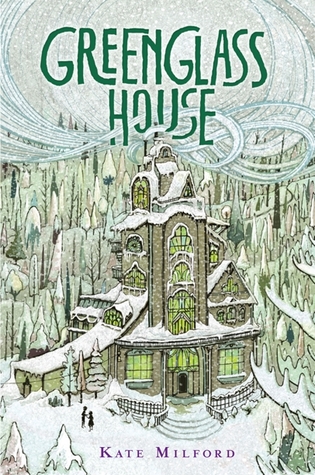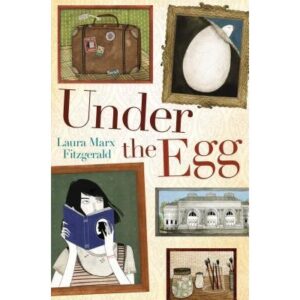 Greenglass House
Greenglass House
By Kate Milford
Clarion Books (an imprint of Houghton Mifflin Harcourt)
$17.99
ISBN: 978-0-544-05270-3
Ages 9-12
On shelves August 26th
When I was a kid I had a real and abiding love of Agatha Christie. This would be around the time when I was ten or eleven. It wasn’t that I was rejecting the mysteries of the children’s book world. I just didn’t have a lot to choose from there. Aside from The Westing Game or supernatural ghostly mysteries sold as Apple paperbacks through the Scholastic Book Fair, my choices were few and far between. Kids today have it better, but not by much. Though the Edgar Awards for best mystery fiction do dedicate an award for young people’s literature, the number of honestly good mystery novels for the 9-12 set you encounter in a given year is minimal. When you find one that’s really extraordinary you want to hold onto it. And when it’s Kate Milford doing the writing, there’s nothing for it but to enjoy the ride. A raconteur’s delight with a story that’ll keep ‘em guessing, this is one title you won’t want to miss.
It was supposed to be winter vacation. Though Milo’s parents run an inn with a clientele that tends to include more than your average number of smugglers, he can always count on winter vacation to be bereft of guests. Yet in spite of the awful icy weather, a guest appears. Then another. Then two more. All told more than five guests appear with flimsy excuses for their arrival. Some seem to know one another. Others act suspiciously. And when thefts start to take place, Milo and his new friend Meddy decide to turn detective. Yet even as they unravel clues about their strange clientele there are always new ones to take their places. Someone is sabotaging the Greenglass House but it’s the kids who will unmask the culprit.
To my mind, Milford has a talent that few authors can boast; She breaks unspoken rules. Rules that have been dutifully followed by children’s authors for years on end. And in breaking them, she creates stronger books. Greenglass House is just the latest example. To my mind, three rules are broken here. Rule #1: Children’s books must mostly be about children. Adults are peripheral to the action. Rule #2: Time periods are not liquid. You cannot switch between them willy-nilly. Rule #3: Parents must be out of the picture. Kill ‘em off or kidnap them or make them negligent/evil but by all means get rid of them! To each of these, Milford thumbs her proverbial nose.
Let’s look at Rule #1 first. It is worth noting that with the exception of our two young heroes, the bulk of the story focuses on adults with adult problems. It has been said (by me, so take this with a grain of salt) that by and large the way most authors chose to write about adults for children is to turn them into small furry animals (Redwall, etc.). There is, however, another way. If you have a small innocuous child running hither and thither, gathering evidence and spying all the while, then you can talk about grown-ups for long periods of time and few child readers are the wiser. If I keep mentioning The Westing Game it’s because Ellen Raskin did very much what Milford is doing here, and ended up with a classic children’s book in the process. So there’s certainly a precedent.
On to Rule #2. One of the remarkable things about Kate Milford as a writer is that she can set a book in the present day (there is a mention of televisions in this book, so we can at least assume it’s relatively recent) and then go and fill it with archaic, wonderful, outdated technology. A kind of alternate contemporary steampunk, if there is such a thing. In an era of electronic doodads, child readers are going to really get a kick out of a book where mysterious rusted keys, old doorways, ancient lamps, stained green glass windows, and other old timey elements give the book a distinctive flavor.
Finally, Rule #3. This was the most remarkable of choices on Milford’s part, and I kept reading to book to find out how she’d get away with it. Milo’s parents are an active part of his life. They clearly care for him, periodically checking up on his throughout the story, but never interfering with his investigations. Since the book is entirely set in the Greenglass House, it has the feel of a stage play (which, by the way, it would adapt to BRILLIANTLY). That means you’re constantly running into mom and dad, but they don’t feel like they’re hovering. This is partly aided by the fact that they’re incredibly busy. So, in a way, Milford has discovered a way of removing parental involvement without removing parental care. The kids are free to explore and solve crimes and the adult gatekeepers reading this book are comforted by the family situation. A rarity if ever there was one.
But behind all the clues and ghost stories and thefts and lies what Greenglass House really is is the story of a hero’s journey. Milo starts out a soft-spoken kiddo with little faith in his own abilities. Donning the mantle of a kind of Dungeons & Dragons type character named Negret, he taps into a strength that he might otherwise not known he even had. There is a moment in the book when Milo starts acting with more confidence and actually thinks to himself, “And I didn’t even have to use Negret’s Irresistible Blandishment . . . I just did it.” Milo’s slow awakening to his own strengths and abilities is the heart of the novel. For all that people will discuss the mystery and the clues, it’s Milo that holds everything together.
Much of his personality is embedded in his identity as an adopted kid too. I love the mention of “orphan magic” that Milford makes at one point. It’s the idea that when something is sundered from its attachments it becomes more powerful in the process. At no point does Milford ever downplay the importance of the fact that Milo is adopted. It isn’t a casual fact that’s thrown in there and then forgotten. For Milo, the fact that he was adopted is part of who he is as a person. And coming to terms with that is part of his journey as well. Little wonder that he gathers such comfort from learning about orphan magic and its potential.
I’m looking at my notes about this book and I see I’ve written down little random facts that don’t really fit in with this review. Things like, “I did wonder if Milo’s name was a kind of unspoken homage to the Milo of The Phantom Tollbooth. And, “The book’s attitude towards smuggling is not all that different from, say, Danny, the Champion of the World’s attitude towards poaching.” And, “I love the vocabulary at work here. Raconteur. Puissance.” There is a lot a person can say about this book. I should note that there is a twist that a couple kids may see coming. It is, however, a fair twist and one that doesn’t cheat before you get to it. For the most part, Milford does a divine job at writing a darned good mystery without sacrificing character development and deeper truths. A great grand book for those kiddos who like reading books that make them feel smart. Fun fun fun fun fun.
On shelves August 26th.
Source: Galley sent from publisher for review.
Like This? Then Try:
- The Westing Game by Ellen Raskin
- The Mysterious Benedict Society by Trenton Lee Stewart
- Escape From Mr. Lemoncello’s Library by Chris Grabenstein
First Sentence: “There is a right way to do things and a wrong way, if you’re going to run a hotel in a smugglers’ town.”
Professional Reviews:
- A star from Kirkus
- Publishers Weekly
Interviews: Milford reveals all with The Enchanted Inkpot.
Misc:
- In lieu of an Author’s Note, Kate provides some background information on Milo and adoption that is worthy additional reading here.
- Cover artist Jaime Zollars discusses being selected to illustrate the book jacket here.
- Read an excerpt of the first chapter at The Book Smugglers.
- Discover how the book came from a writing prompt here.




Hi Elizabeth- This looks like a great mystery! You are so right in that there are few mysteries for kids. Glad to see this one!
Definitely looking forward to this one. There have been a few more good mysteries than usual this year, but it is hard to find one that appeals to students, since my students (at least) seem to crave gruesome murder stories! The cover alone, and the English setting, sold me on this one.
Just rubbing it in aren’t you? Hmph.
All that plus Jaime Zollars? I’m in! (fwiw, We’re reading Under the Egg right now — another really good mystery, tho not Westing-Game-esque in that there’s no collection of suspects. Two girls solving a long-ago mystery about the provenance of a secret painting. Only halfway thru now, but both kid and me are loving it.)
Kate is one of the very best on the business, we’re lucky to have her creating books for us. Can’t wait for this one.
Yep, that’s the other good mystery of the year. I’m a big fan of that one too.
Aw yeah, baby. Aw yeah.
Well, I should note that there isn’t a single body in this book, except for a couple from the past. Surprisingly little bloodshed all around.
Childhood Christie fan here too, mon ami, and I can’t wait to read this!